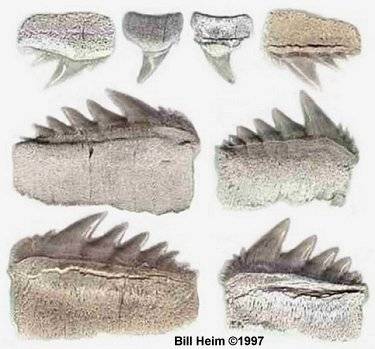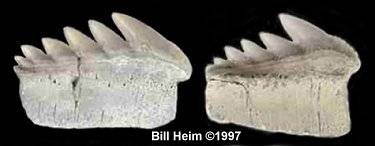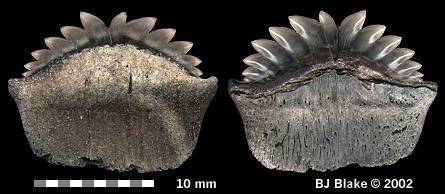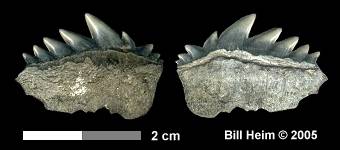Notorynchus cepedianus (PERON, 1807)
aka N. primigenius (AGASSIZ, 1843)
 Notorynchus primigenius allegedly differs from the modern N. cepedianus
(PERON, 1807)
by having more erect cusps. However variations in the modern tooth form (and the
fossils as illustrated) makes this a somewhat dubious distinction. Thus I believe
the fossil species to be the same as the modern one. A potential source of
confusion occurs in that the fossil species naming predates the modern species.
Illustrated in both lingual and labial views are: an anterior
upper tooth (Pungo), a lateral upper tooth (Pungo), a male lower lateral tooth (Yorktown),
and an unusually large female lower lateral tooth (Yorktown). The posterior teeth are
minute, irregular, and stubby and would be barely recognizable as a tooth. In addition to
being smaller, these teeth differ from Hexanchus in having less cusps on the
lower teeth (7 vs 8 - 12+) and larger more recurved serrations on the anterior side of the
tooth which don't extend as far down along the front of the root.
Notorynchus primigenius allegedly differs from the modern N. cepedianus
(PERON, 1807)
by having more erect cusps. However variations in the modern tooth form (and the
fossils as illustrated) makes this a somewhat dubious distinction. Thus I believe
the fossil species to be the same as the modern one. A potential source of
confusion occurs in that the fossil species naming predates the modern species.
Illustrated in both lingual and labial views are: an anterior
upper tooth (Pungo), a lateral upper tooth (Pungo), a male lower lateral tooth (Yorktown),
and an unusually large female lower lateral tooth (Yorktown). The posterior teeth are
minute, irregular, and stubby and would be barely recognizable as a tooth. In addition to
being smaller, these teeth differ from Hexanchus in having less cusps on the
lower teeth (7 vs 8 - 12+) and larger more recurved serrations on the anterior side of the
tooth which don't extend as far down along the front of the root.
 |
Fig. 1 Notorynchus cepedianus
Top: Upper lateral (side) & anterior (middle),
lingual teeth on left.
Bottom: Lower lateral female (left) & male (right)
lingual above & labial below, female width 33 mm |
Also illustrated are lingual views of Notorynchus female (left) and male (right)
lower lateral teeth from the same jaw position from the Pungo and Yorktown formatons
respectively. Notice the more erect cusplets and greater relative size and separation
of the first cusp from the remaining cusps in the male tooth.
 |
Fig. 2 Notorynchus cepedianus
Lingual views of similarly positioned lower laterals.
Female from Pungo River (left) and male from Yorktown
(right). Width of female tooth is 27 mm |
The below specimen is a symphyseal Notorynchus tooth from the
Pungo River formation. Note, one cusp is missing. Presence or absence
of the center cusp is not indicative of genus as this varies by individual.
The best method is by size, a Hexanchus symphyseal tooth would
typically be quite a bit larger than this one.
 |
Fig. 3 Notorynchus cepedianus
Pungo River symphyseal, width 16 mm |
 |
Fig. 4 cf Notorynchus cepedianus
Pungo River symphyseal, from the collection of B.J. Blake |
 |
Fig. 5 cf Notorynchus cepedianus
patho symphysio-lateral |